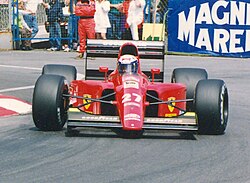 Alain Prost driving the 642 at the 1991 Monaco Grand Prix | |||||||||||
| Category | Formula One | ||||||||||
|---|---|---|---|---|---|---|---|---|---|---|---|
| Constructor | Ferrari | ||||||||||
| Designers | Steve Nichols (Technical Director) Pierguido Castelli (Technical Coordination Director) Jean-Claude Migeot (Chief Designer) Franco Ciampolini (Head of Electronics) Paolo Massai (Engine Department Director) | ||||||||||
| Predecessor | 641 | ||||||||||
| Successor | 643 | ||||||||||
| Technical specifications [1] | |||||||||||
| Chassis | Carbon fibre composite monocoque | ||||||||||
| Suspension (front) | Double wishbones, push-rod actuated torsion bar springs and telescopic shock absorbers, anti-roll bar | ||||||||||
| Suspension (rear) | Double wishbones, push-rod actuated coil springs over telescopic shock absorbers, anti-roll bar | ||||||||||
| Axle track | Front: 1,800 mm (71 in) Rear: 1,675 mm (65.9 in) | ||||||||||
| Wheelbase | 2,830 mm (111 in) | ||||||||||
| Engine | Ferrari Tipo 037, 3,499 cc (213.5 cu in), 65° V12, NA, mid-engine, longitudinally-mounted | ||||||||||
| Transmission | Ferrari 7-speed semi-automatic | ||||||||||
| Power | 710-725 hp @ 13,800-14,500 rpm [2] [3] | ||||||||||
| Weight | 505 kg (1,113 lb) | ||||||||||
| Fuel | Agip | ||||||||||
| Tyres | Goodyear | ||||||||||
| Competition history | |||||||||||
| Notable entrants | Scuderia Ferrari SpA | ||||||||||
| Notable drivers | 27. 28. | ||||||||||
| Debut | 1991 United States Grand Prix | ||||||||||
| Last event | 1991 Mexican Grand Prix | ||||||||||
| |||||||||||
The Ferrari 642 (also known as the Ferrari F1-91) [4] was a Formula One racing car designed by Steve Nichols and Jean-Claude Migeot and was used by Scuderia Ferrari in the 1991 Formula One season. It was a development of the team's 641 chassis, which had mounted a championship challenge in 1990.
Ferrari started the 1991 season with high hopes of winning the championship. Jean Alesi signed a contract with the Scuderia when Nigel Mansell returned to the Williams team. The 642's best result was a second place taken by Alain Prost at the 1991 United States Grand Prix, held at the Phoenix street circuit.
The 642 was replaced by the Ferrari 643 at the 1991 French Grand Prix.